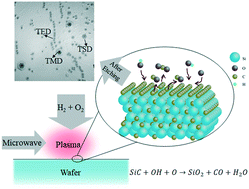Revelation of the dislocations in the C-face of 4H-SiC substrates using a microwave plasma etching treatment
Abstract
A novel microwave plasma etching technique was used to reveal various types of dislocation on the C-face of 4H-SiC. Etch pits formed on the C-face of 4H-SiC by H2–O2 plasma etching were observed using a laser confocal microscope. Combining the sectional views and morphology of the etch pit, three types of threading dislocations were identified. For further verification, the Si-face was etched in molten KOH and compared with the C-face. In order to comprehend the mechanism of the microwave plasma etching of the C-face, an etching rate experiment was carried out. The etching rate exhibited Arrhenius-type temperature dependence and the activation energy was 29.5 kcal mol−1, indicating a surface reaction limited process. X-ray photoelectron spectroscopy was used to analyze the change in the chemical state of the C-face before and after plasma etching, so as to infer the chemical reaction that occurred during the etching process. This etching technique provides an affect method by which to investigate the propagation of dislocations in SiC crystals.

- This article is part of the themed collection: Crystal Growth


 Please wait while we load your content...
Please wait while we load your content...